Manipur, a state in northeastern India, is a tapestry of vibrant traditions, art and culture and a rich historical legacy. This picturesque region is renowned for its unique blend of ethnic diversity and cultural expression.
One of the most distinctive facets of culture of Manipur is its traditional dance forms, particularly the graceful and ritualistic “Ras Leela” and “Thang Ta.” These dances of Manipur are an integral part of religious and social events, portraying mythological tales and martial arts prowess. Manipur’s diverse ethnic groups, primarily the Meiteis, Nagas, and Kukis, contribute to a colorful mosaic of customs, languages, and festivals. The Meitei people, in particular, celebrate their indigenous festivals like Lai Haraoba and Yaoshang with fervor and joy.
Manipur’s cuisine reflects its local produce, with dishes like Eromba and various chutneys infused with the fiery Bhut Jolokia pepper. The state’s handicrafts, such as intricate handwoven textiles and delicate bamboo work, are esteemed for their craftsmanship.
The region’s cultural vibrancy is bolstered by its historical significance and natural beauty, making Manipur a cultural gem that continues to enchant and captivate visitors from around the world.
History of Manipur
Manipur, a state in northeastern India, boasts a rich and diverse history, with its origins tracing back to the Bronze Age. The Meitei people were among the early inhabitants, and the region witnessed the rise and fall of several kingdoms and empires, including the flourishing Meitei Kingdom in the 1st century AD.
During the colonial era, Manipur came under British rule in the late 19th century and remained a princely state until India gained independence in 1947. Post-independence, it integrated into the Indian Union.
However, Manipur’s history is marked by ethnic and political conflicts, with numerous indigenous communities seeking greater autonomy and recognition. The Naga insurgency and the Mizo insurgency during the late 20th century had significant repercussions on the region.
In terms of more recent history, records indicate Manipur’s existence around 900 CE. Notable events include a treaty between Raja Jai Singh and the British in 1762 to repel Burmese invaders. Disputed successions led to political turmoil until Chura Chand became the raja in 1891, and British supervision was instituted for eight years, leading to social reforms.
Manipuri governance went through various changes until it joined India in 1947, becoming a union territory and eventually achieving full statehood on January 21, 1972. This historical journey reflects the complex tapestry of Manipur’s past, marked by both ancient traditions and modern political transformations.
Festivals of Manipur
These are few of the many festivals celebrated in Manipur, reflecting the culture of Manipur and the diversity of its communities. Each festival is an opportunity for people to come together, celebrate, and express their cultural identity.
Cheiraoba : The Manipur New Year
Cheiraoba, one of the main culture of Manipur and most renowned festivals, unfolds on the first day of the Sajibu month, typically falling in March or April. This joyous occasion, often referred to as the Spring Festival, is a vibrant celebration of culture and community. Festivities center around donning traditional attire, paying visits to friends and family, exchanging warm greetings and gifts, and relishing local delicacies. Central to Cheiraoba is the veneration of the regional goddess Sanamahi, adding a spiritual dimension to the festivities.
Preparations for the festival encompass sprucing up homes and adorning them with colorful decorations. Culinary delights hold a special place, as locals craft special dishes, initially offered to various deities as a mark of devotion. In April, a unique ritual involves villagers ascending the nearby hilltops, believing that this act will elevate their prospects in life, symbolizing their aspirations to reach greater heights. Cheiraoba is a beautiful tapestry of tradition, faith, and togetherness in Manipur’s cultural mosaic.
Yaoshang Festival
Celebrated for five days commencing from the full moon day of Phalguna (February/March), Yaoshang is the premier festival and culture of Manipur. The Thabal Chongba – a kind of Manipuri fold dance, where boys and girls hold hands together and sing and dance in a circle, is particularly associated with this festival. Boys and girls and even old women collect donations from house to house and the money so collected is spent on parties and feasts. Indeed, Yaoshang to Manipur is what Durga Puja is to Bengal, Diwali in north India and Bihu to Assam.
Lui Ngai Ni
Lui Ngai Ni, the seed-sowing festival, marks the start of the Manipur season and is a prominent celebration among the tribes in Manipur. This festival, rich with enthusiasm, is the centerpiece of Manipur’s festivities. Its name, “Lui-Ngai-Ni,” is a unification of three Naga tribal languages, all signifying the act of sowing seeds. During this festival, tribal communities pay their respects to the deity of crops through joyful dancing and singing. For a distinctive and thrilling experience, consider attending one of the most captivating Manipur festivals in 2022.
Kang (Rath Yatra):
The Kang Festival, a significant celebration for the Hindu community in Manipur, spans ten days in July. It centers around Lord Jagannath’s departure from his temple in a vehicle called the “Kang,” which is pulled by enthusiastic devotees competing for the honor. The festival, also known as Rath Yatra, unfolds at the Govindjee temple in Manipur annually. During this event, idols of Jagannatha, Balarama, and Subhadra are transported in the Kang, which is a local term for a chariot.
Devotees, filled with zeal, pull the Kang and accompany it with the sounds of nahal, gongs, bells, drums, and conch instruments. As a gesture of devotion, they offer barti, which are cotton balls soaked in ghee, to the deities during the yatra. The festivities continue with communal feasts held in the evenings, making this ten-day celebration one of the most significant festivals in Manipur.
Kut Festival:
The autumn festival of the Kuki-Chin-Mizo tribes in Manipur is known by different names, such as Chavang Kut or Khodou, depending on the specific tribe. It’s a joyous occasion for villagers who have worked hard throughout the year and are now blessed with an abundance of food. This festival is celebrated on the 1st of November annually and is one of Manipur’s most prominent and colorful celebrations.
The Kut festival has transformed over time into a symbol of peace, unity, communal bonds, and friendship. Also referred to as Chavang-Kut or Khodou, it serves as a way to express gratitude to the deities for the year’s bountiful harvest through singing, dancing, and revelry.
Gang-Ngai Festival:
Gang Ngai is a vibrant celebration of the customs and traditions of the Kabui Nagas in Manipur, spanning five joyous days. The initial day is dedicated to paying homage to their ancestors. The subsequent four days are filled with indulgent feasts, lively dancing, melodious singing, and a diverse range of programs. The tribe showcases their rich musical heritage through the enchanting sounds of their ethnic instruments. Additionally, this festive occasion includes the heartwarming exchange of gifts among community members.
Chumpha Festival:
The Chumpha Festival, celebrated for seven days in December by the Rangkhul Nagas, is a significant event following the harvest season. The last three days are dedicated to social gatherings and joyful celebrations. This festival is also observed by the Tanghul Nagas, and it’s one of Manipur’s popular festivities, spanning a week after the harvest. During this time, people come together to celebrate the year’s harvest with great enthusiasm, particularly during the final three days.
Sangai Festival:
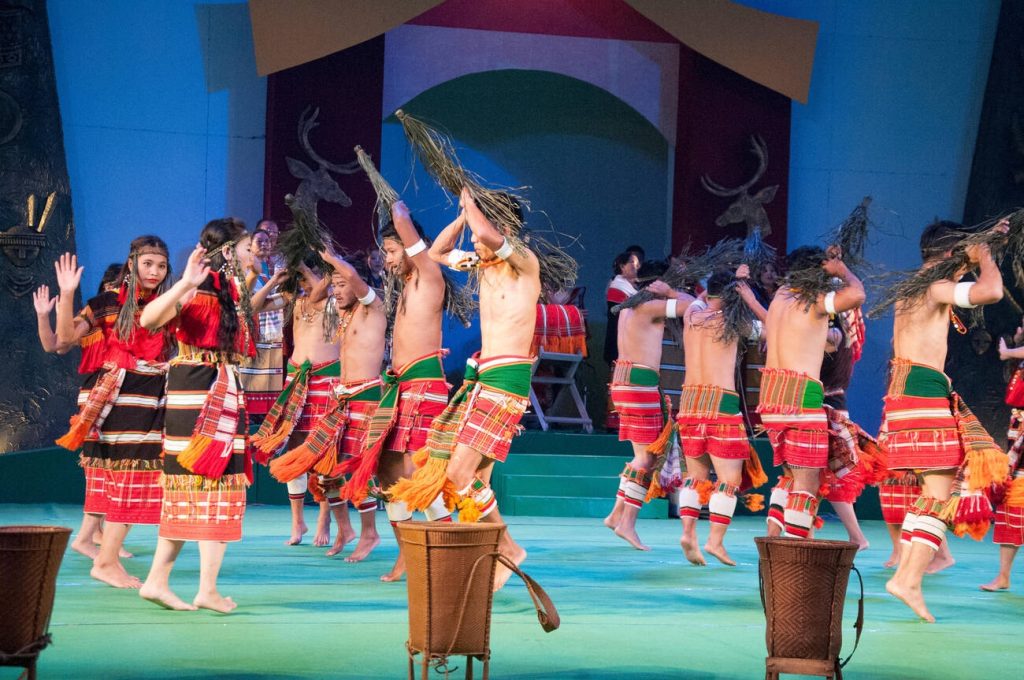
The Manipur Sangai Festival, an annual event held in November, has been a vibrant culture of Manipur celebrated since its inception in 2010. Over the years, it has become a significant platform for showcasing the indigenous art and culture of Manipur. The festival offers a delightful array of dance, music, and sports performances, as well as exhibitions featuring local handicrafts and cuisine.
As a part of the Manipur Sangai Festival 2022, the Manipur Film Festival is jointly organized by MSFDS and Film Forum Manipur, showcasing movies and short films created by local directors. This endeavor contributes to the promotion of Manipur’s film industry on a national and international scale.
Cuisines of Manipur
The cuisines of Manipur, a northeastern state in India, is diverse and reflects the rich cultural of Manipur and the heritage of the region. Here are some details about Manipuri cuisine:
Rice:
Rice is a staple food in Manipur. Various varieties of rice are grown in the region, and rice is the primary component of most meals.
Fish and Meat:
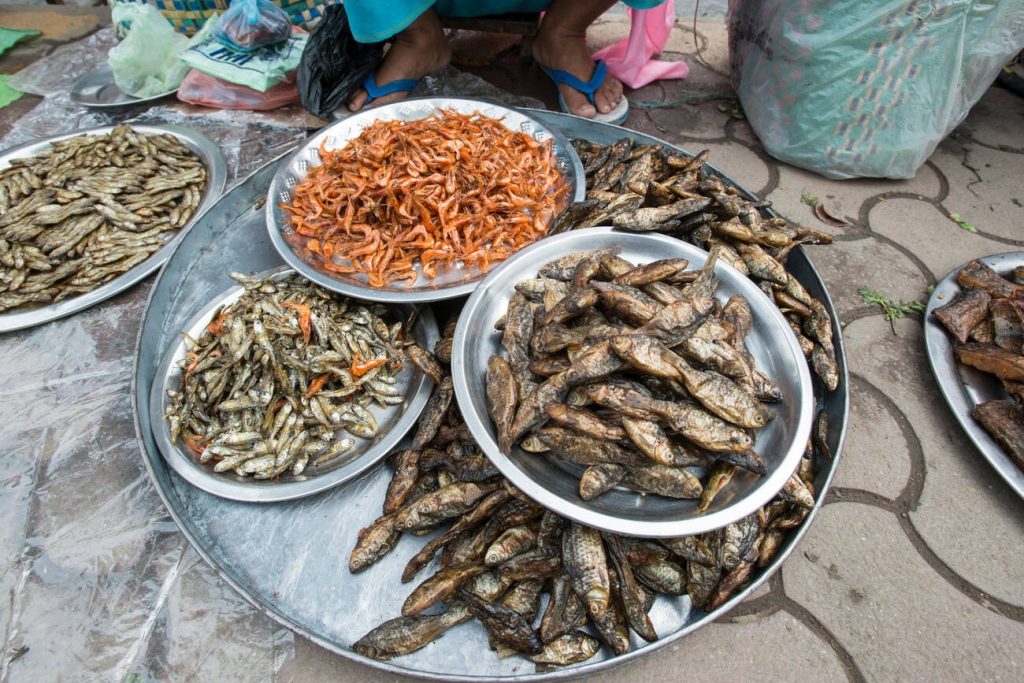
Manipuris are fond of fish, and it’s a famous cuisine in Manipur and a key part of their diet. Various fish preparations, both dried and fresh, are popular. Meats like chicken, pork, and mutton are also commonly consumed.
Vegetables:
Manipur has a rich tradition of growing a variety of vegetables. Leafy greens, bamboo shoots, lotus stems, and various herbs are widely used.
Iromba:
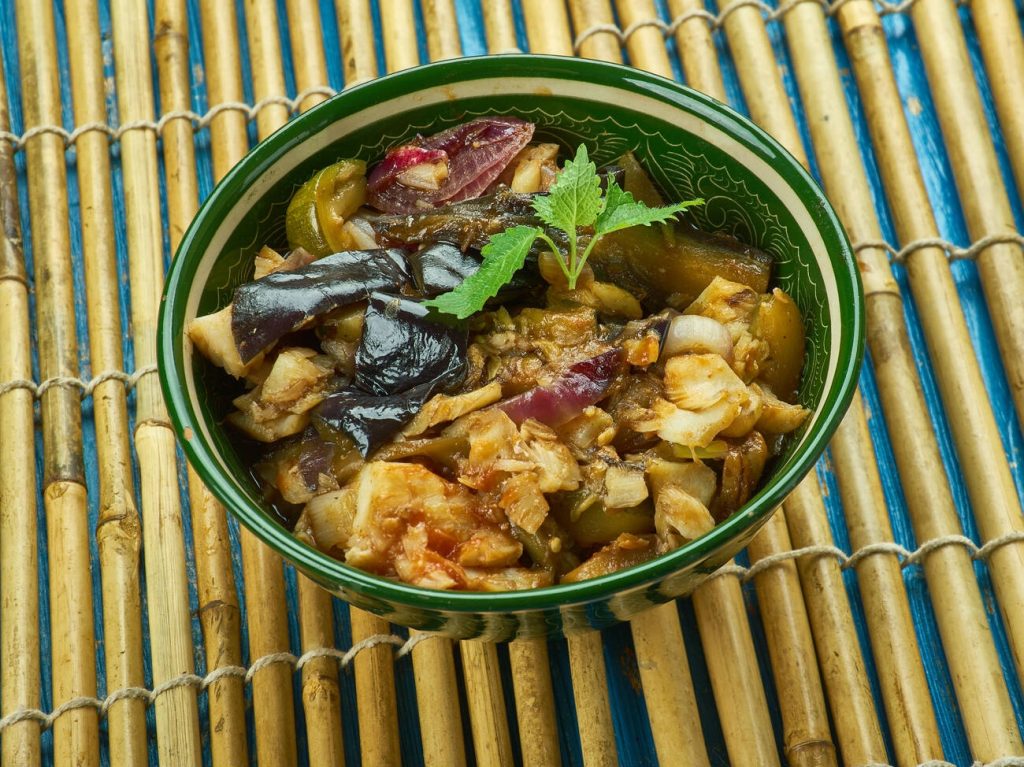
This is a traditional Manipuri dish made from mashed vegetables (usually potatoes and leafy greens) mixed with fermented fish or shrimp. It has a unique, pungent flavor.
Eromba:
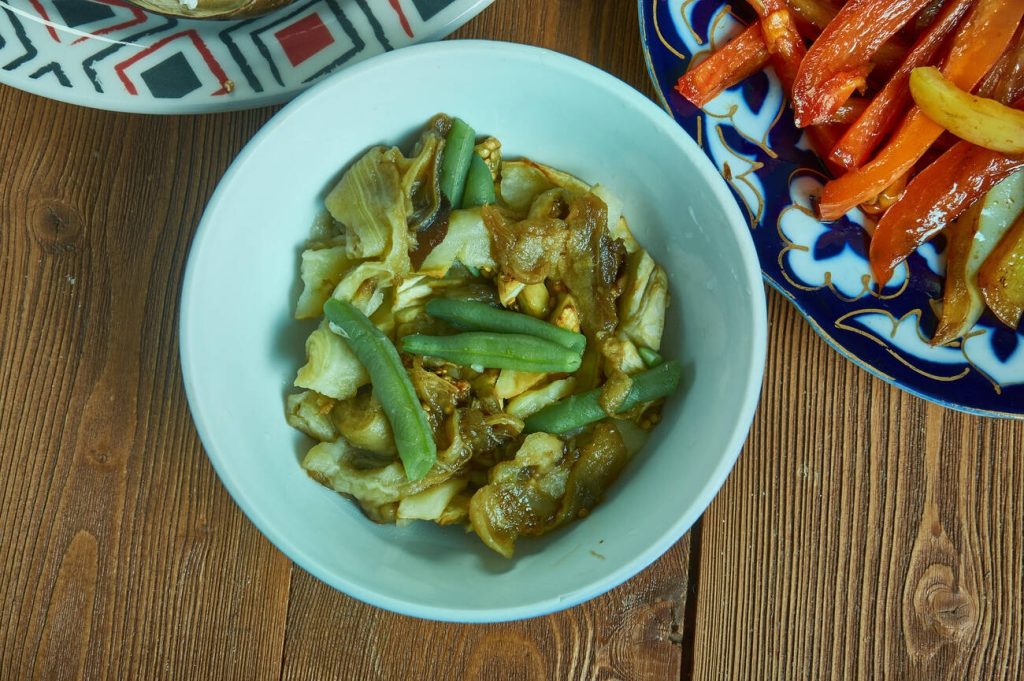
Similar to Iromba, Eromba is a curry made with vegetables and fermented fish. It’s known for its strong, spicy taste.
Rice-based Dishes:
Manipuris have various rice-based dishes such as ‘Chak-hao Kheer,’ a black rice pudding, and ‘Eromba,’ a rice and fish stew.
Singju:
This is a popular Manipuri salad made from raw vegetables and herbs. It’s a healthy and refreshing dish.
Sticky Rice:
Sticky rice is also a part of Manipuri cuisine, and it’s often used in desserts and snacks.
Chutneys:
Manipuri chutneys are famous for their fiery and tangy flavors. The ‘U-morok’ (chili chutney) is a must-try for those who enjoy spicy food.
Fermented Foods:
Fermentation plays a significant role in Manipuri cuisine. Various foods are fermented, such as bamboo shoots, fish, and soybeans, adding unique flavors to the dishes.
Sana Thongba:
This is a popular Manipuri dish made with paneer-like cottage cheese cooked in a savory gravy.
Thali:
A traditional Manipuri meal often includes a thali, which consists of rice, vegetables, fish or meat preparations, and chutneys.
Tea and Snacks:
Manipuris enjoy tea, and tea stalls are a common sight. Snacks like ‘Singju’ and ‘Pakora’ are often served with tea.
Sweets:
Manipur has its share of sweets, including ‘Chamthong,’ a rice dessert, and ‘Morok Metpa,’ a sweet chili preparation.
Local Brews:
Rice beer is a traditional drink in Manipur and is consumed during festivals and social gatherings.
Manipur’s cuisine is known for its use of local ingredients, unique flavors, and a balance of spicy and tangy tastes. It’s deeply rooted in the culture and traditions of the state, making it a fascinating culinary experience for those who have the opportunity to try it.
Dresses of Manipur
Traditional Manipuri clothing has long been a culture of Manipur and cornerstone of fashion, blending ethnic trends with ease. Prioritizing comfort and functionality, these vibrant outfits maintain a connection to ancient concepts.
Yet, fashion in Manipur has evolved, with the younger generation infusing new elements into these time-honored garments, resulting in a debonair blend of tradition and modernity. Explore Manipuri conventional wears to elevate your fashion game with a touch of uniqueness. Some of the dresses of Manipur are:
Inaphi:
Inaphi is an intricate traditional wraparound shawl worn by Manipuri women. It is made from fine cotton fabric and is known for its vibrant colors and unique patterns. Inaphi is an essential part of the Manipuri women’s attire, and it is draped elegantly around the body.
Phanek:
The Phanek is the traditional skirt of Manipur. It is usually woven from cotton and comes in various designs and colors. Women wear the Phanek by wrapping it around their waist and securing it with pleats. It’s a fundamental element of traditional Manipuri attire.
Mayek Naibi:
Mayek Naibi is a traditional blouse worn by Manipuri women. It is often brightly colored and decorated with intricate embroidery or designs. The Mayek Naibi complements the Phanek and Inaphi, completing the ensemble.
Lai Phi and Chin Phi:
Lai Phi and Chin Phi are traditional ornaments worn by Manipuri women. Lai Phi is a circular-shaped pendant with intricate designs, often depicting deities or natural motifs. Chin Phi, on the other hand, is a type of necklace or chain adorned with various pendants, including Lai Phi. These ornaments are considered auspicious and add elegance to the attire.
Dhoti-Pagri/Khamen Chapta:
Manipuri men often wear a traditional outfit that includes a dhoti (a piece of cloth wrapped around the waist) and a Pagri (turban) or Khamen Chapta (headwear) depending on the occasion. The colors and patterns of these garments can vary and hold cultural significance.
Potloi:
The Potloi is a traditional dress worn by Manipuri brides. It’s a special and elaborately designed ensemble, often adorned with intricate embroidery and motifs. The Potloi is a symbol of beauty and grace and is typically worn during weddings and other important ceremonies.
Marriage traditions in Manipur
In Manipuri weddings, the ceremony unfolds at the bride’s residence. The groom, accompanied by his family, is warmly welcomed by three elder female members of the bride’s family, offering betel leaves and betel nuts on banana leaves. The wedding mandap, centered around a tulsi plant, serves as the focal point for rituals.
The groom, alongside the priest, recites prayers while the bride joins later. They unite their hands, bound by thread and blessed by the bride’s mother, who presents a plate with coconut, banana, betel leaf, and betel nut. Elders offer blessings and monetary gifts, and the couple exchanges garlands after the bride’s seven rounds around the groom.
Music
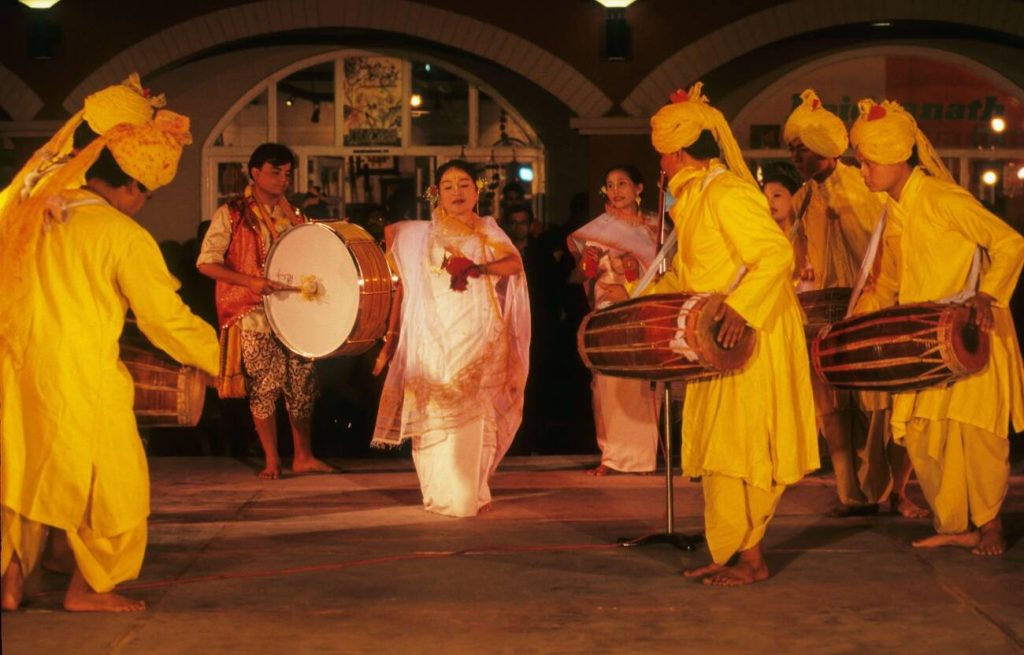
Manipur, a region in North-East India, boasts a rich musical heritage. It encompasses the culture of Manipur and has a diverse range of folk music traditions, including Khullang Eshei, which are rural love songs, the rhythmic Lai Haraoba eshei with veiled references to erotic mysticism, and pena eshei, accompanied by the traditional pena instrument made from bamboo and gourd or coconut shells. The pena holds a special place as a symbol of Manipuri culture.
In addition to folk music, Manipur features classical nat music performed on special occasions, devotional nupi pala songs sung by women, Gaur Padas praising Chaitanya Mahaprabhu, and dhob songs accompanied by the jhal, a large cymbal. Manohar Sai songs, dedicated to a notable figure from the 19th century, and Khubakeshei songs that rely solely on clapping are also significant elements of Manipuri music.
Instruments used in Manipur
Pung:
A type of drum made from wood and animal skin, used in Manipuri classical dance performances.
Khol:
Another traditional drum made from clay and animal skin, often used in Manipuri music and dance.
Mridang:
A barrel-shaped drum, typically played during Manipuri folk and classical music performances.
Khartal:
A pair of wooden clappers that are commonly used as a percussion instrument in folk and devotional music.
Esraj:
A stringed musical instrument resembling a violin, used in classical Manipuri music.
Flutes:
Bamboo flutes are used in various folk and traditional music forms in Manipur.
Pena:
A unique, plucked string instrument, often played during traditional Manipuri music and dance.
Leirum Pena:
A single-stringed instrument with a resonator made from a bamboo tube, commonly used in Manipuri folk music.
Trombone and Trumpet:
Western brass instruments are sometimes incorporated into contemporary Manipuri music.
Art,Crafts and Handicrafts
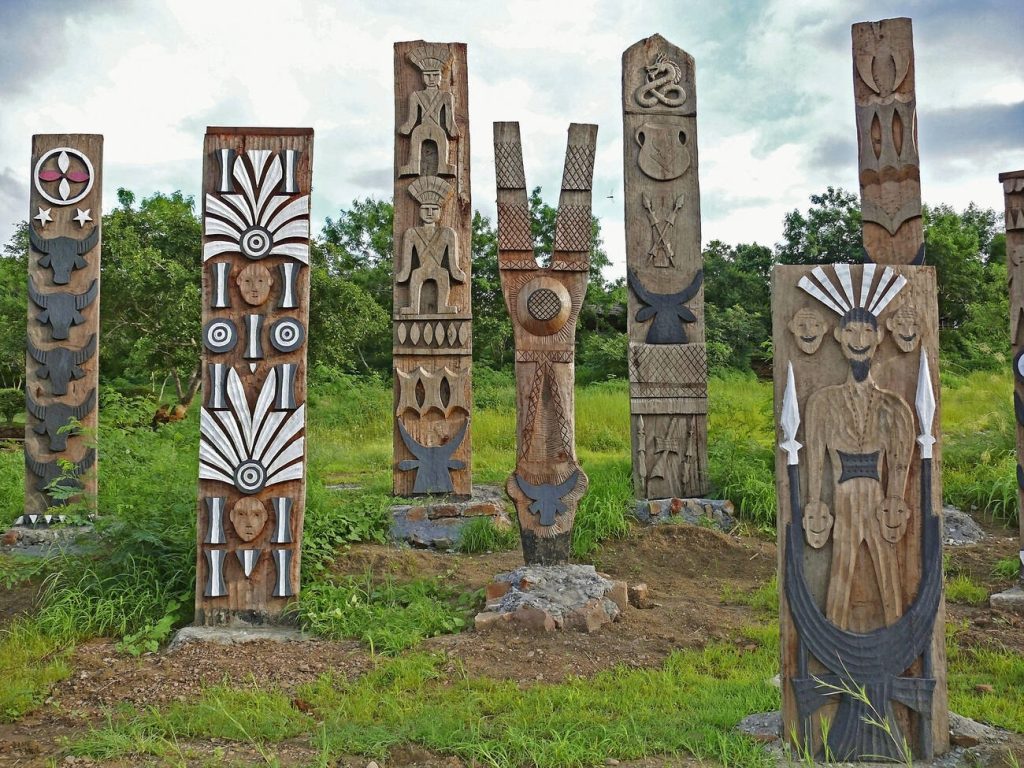
Manipur, a state in northeastern India, has a rich tradition of art, crafts, and handicrafts. Here are some of the notable ones:
Handloom and Textiles:
Manipur is renowned for its handwoven textiles. Moirangphee and Leirum are popular traditional fabrics. The state produces exquisite shawls, sarongs, and phaneks (wraparound skirts) with intricate motifs and designs.
Pottery:
The traditional pottery of Manipur is distinctive for its black pottery, also known as Longpi pottery. These items are made using a unique clay mixture and are known for their durability and aesthetics.
Bamboo and Cane Craft:
Manipur’s artisans are skilled in bamboo and cane craft, creating a wide range of products such as baskets, furniture, mats, and even traditional weapons like the bamboo spear.
Wood Carving:
Skilled woodcarvers in Manipur create intricate designs on furniture, household items, and decorative pieces. Wood carving is an art form passed down through generations.
Jewelry:
Manipuri jewelry often features intricate designs and vibrant colors. Silver jewelry, in particular, is popular among the people of Manipur, with unique designs for necklaces, bangles, and earrings.
Manipuri Phulkari:
This is a unique form of embroidery practiced in the state. Women create colorful and intricate floral designs on shawls and textiles using silk threads.
Paintings:
Manipuri artists are known for their traditional and contemporary paintings. The themes often revolve around nature, religious motifs, and daily life in Manipur.
Dolls and Toys:
Doll making is a popular craft in Manipur. Artisans create beautiful, handmade dolls that often reflect the traditional attire and culture of the region.
Thangka Painting:
While Thangka painting is more commonly associated with Tibetan culture, it is also practiced in some parts of Manipur. Thangkas are intricate scroll paintings often depicting Buddhist deities and narratives.
FAQs
How many cultures are there in Manipur ?
-Manipur is a diverse state in northeastern India with a rich cultural tapestry. It is home to several ethnic communities and cultures. There are over 29 major tribes in Manipur, with the Meiteis being one of the largest groups. Each of these tribes has its own distinct culture, traditions, and languages. So, there are numerous distinct cultures in Manipur, making it a culturally vibrant and diverse state.
What are the cultural symbols of manipur?
Manipur, a northeastern Indian state, has several cultural symbols. The “Ras Lila” dance depicts Krishna’s life, celebrated during festivals. The “Phanek” is a traditional wraparound skirt worn by women. The “Nongma Panba” is a boat race symbolizing unity. The “Sangai” deer is an endangered species and the state’s emblem.
What is the cultural dress of Manipur?
The traditional attire of Manipur varies among its different ethnic communities. However, one of the most well-known traditional dresses in Manipur is the “Phanek” for women. It’s a wraparound skirt often woven with intricate designs. Men typically wear a “Phee,” which is a kind of cloth wrapped around the waist. The clothing can be quite colorful and reflects the cultural diversity of the region. There are also various shawls, headgear, and accessories that are part of the traditional attire in Manipur.
Why is Manipur called the Jewel of India?
Manipur is often referred to as the “Jewel Land” of India due to its unique geography, featuring an oval-shaped valley encircled by nine picturesque hills, resembling a naturally formed jewel.
What is the main festival of Manipur?
The main festival of Manipur is called “Lai Haraoba.” It is a traditional festival that celebrates the Manipuri belief in the indigenous deities and the Meitei culture. Lai Haraoba typically involves various rituals, music, dance, and performances that showcase the rich cultural heritage of Manipur.


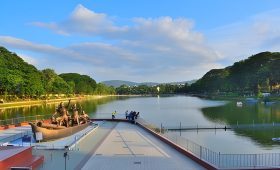
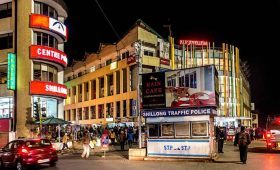
I’ve been browsing online greater than 3 hours lately, yet I by
no means found any attention-grabbing article like yours.
It is pretty value sufficient for me. In my opinion, if all website owners and bloggers
made good content material as you did, the web will
probably be a lot more useful than ever before.
Hey there! Would you mind if I share your
blog with my twitter group? There’s a lot of folks that I think would really appreciate your content.
Please let me know. Thanks
It is perfect time to make some plans for the future and it’s time
to be happy. I’ve read this post and if I could I wish to suggest you few interesting things or advice.
Maybe you could write next articles referring to this article.
I want to read even more things about it!
This blog beautifully captures the essence of Manipur’s rich cultural heritage. It’s a fascinating journey into traditions, rituals, and customs that have been cherished for generations. Well-written and insightful!